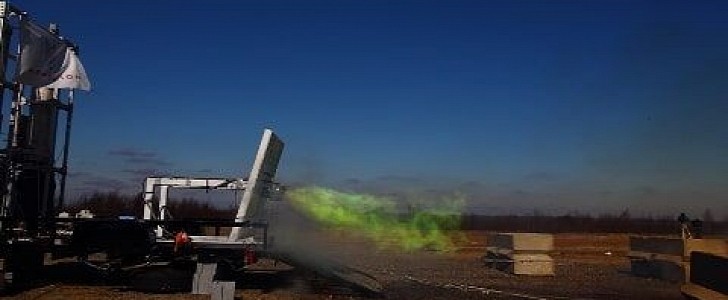The space industry is experiencing unprecedented growth, and satellite launch services providers are a big part of that. One of them is a young company based in Wyoming called Aphelion Aerospace, which recently completed rocket engine tests for its future Helios launch vehicle.
Aphelion is one of the many companies that want to revolutionize access to space. It plans to do that by miniaturizing and mass-producing launch vehicle technology, which means that it’s developing a rocket that’s low-cost and scalable, intended for regular nanosatellite launch service.
Helios is a three-stage vertical launch vehicle using liquid propulsion for the first two stages and solid propulsion for the third one. The company claims that the first-stage propellants and the engine design are “common” but that the hypergolic propellant is unique. Aphelion says that it’s using a proprietary chemical blend that was only used in government-funded laboratory research until now. This would be the first time that a company is using it in a flight-scale rocket engine.
This technology can be seen as groundbreaking due to the fact that it’s non-toxic, non-cryogenic, environmentally friendly, and affordable. In turn, this will allow low-cost, on-demand launch services specifically dedicated to nanosatellites.
Together with its propulsion R&D partner, Frontier Astronautics, Aphelion conducted a series of hot fire tests at its facility in Wyoming. Over the course of two weeks, the propulsion technology underwent extensive ground testing. This is an important step for the company that plans to conduct its first suborbital launch by the end of this year. Following the qualification of the complete propulsion system, including the engines, the electric pumps, and the engine controllers, an orbital launch will take place in 2024.
The Helios rocket will also replace conventional radar-based flight safety systems with an autonomous one, which is supposed to cut costs even further while also boasting advanced materials and the use of additive manufacturing.
[YOUTUBE=https://youtu.be/e0vKIa-Mv6A
Helios is a three-stage vertical launch vehicle using liquid propulsion for the first two stages and solid propulsion for the third one. The company claims that the first-stage propellants and the engine design are “common” but that the hypergolic propellant is unique. Aphelion says that it’s using a proprietary chemical blend that was only used in government-funded laboratory research until now. This would be the first time that a company is using it in a flight-scale rocket engine.
This technology can be seen as groundbreaking due to the fact that it’s non-toxic, non-cryogenic, environmentally friendly, and affordable. In turn, this will allow low-cost, on-demand launch services specifically dedicated to nanosatellites.
Together with its propulsion R&D partner, Frontier Astronautics, Aphelion conducted a series of hot fire tests at its facility in Wyoming. Over the course of two weeks, the propulsion technology underwent extensive ground testing. This is an important step for the company that plans to conduct its first suborbital launch by the end of this year. Following the qualification of the complete propulsion system, including the engines, the electric pumps, and the engine controllers, an orbital launch will take place in 2024.
The Helios rocket will also replace conventional radar-based flight safety systems with an autonomous one, which is supposed to cut costs even further while also boasting advanced materials and the use of additive manufacturing.
[YOUTUBE=https://youtu.be/e0vKIa-Mv6A





